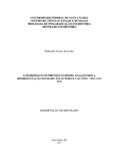| dc.creator | Lima, Eduardo Leote de | |
| dc.date.accessioned | 2021-12-14T12:38:17Z | |
| dc.date.available | 2021-12-14T12:38:17Z | |
| dc.date.issued | 2021-03-31 | |
| dc.identifier.uri | http://repositorio.ufsm.br/handle/1/23289 | |
| dc.description.abstract | The present work comprehends the representation of the Devil in the 16th century
from the works of two Protestant authors: Martin Luther (1483-1546) and John Calvin (1509-
1564). Our objective is to analyze the process of individualization of the logic of salvation in
the period and the consequent absorption of the diabolic figure into our conscience, listing
how this phenomenon was closely linked with others, such as the establishment of patterns of
behavior, the control and the self-control of consciences and bodies, the establishment of
power relations, and the birth of modernity itself. In this way, a research is carried out from a
comparative and at the same time complementary approach to the sources, that is, to analyze
them in order to understand which form the Devil is represented in each one and how they,
together, help in the construction than was the idea of Demon at the time. At the same time,
an approach is sought that represents an interdisciplinarity between the areas of history and
psychology, in order to consider the Devil as the fruit of the very historical conditions of his
creation at the same time that he sees him as cognitive responses to the pressures of the
environment. Thus, we work with a theoretical and methodological tool that brings together
Cultural History, especially the concepts of representation and speech, by Roger Chartier, as
well as areas of Social Psychology, such as the case of Casual Attribution, and the Cognitive
Science of Religion, with the evolutionary psychology. The research is part of the research
line Border, Politics and Society, of the Postgraduate Program in History of the Federal
University of Santa Maria (PPGH-UFSM), at the master’s level. | eng |
| dc.language | por | por |
| dc.publisher | Universidade Federal de Santa Maria | por |
| dc.rights | Attribution-NonCommercial-NoDerivatives 4.0 International | * |
| dc.rights.uri | http://creativecommons.org/licenses/by-nc-nd/4.0/ | * |
| dc.subject | Demônio | por |
| dc.subject | Representação | por |
| dc.subject | Reforma protestante | por |
| dc.subject | Devil | eng |
| dc.subject | Representation | eng |
| dc.subject | Protestant reformation | eng |
| dc.title | O demoníaco no protestantismo: analisando a representação do diabo em Lutero e Calvino – século XVI | por |
| dc.title.alternative | The demonic in protestantism: analyzing the devil's representation in Luther and Calvin - 16th century | eng |
| dc.type | Dissertação | por |
| dc.description.resumo | O presente trabalho busca compreender a representação do Demônio no século XVI a
partir das obras de dois autores protestantes: Martinho Lutero (1483-1546) e João Calvino
(1509-1564). Nosso objetivo é analisar o processo de individualização da lógica da salvação
existente no período e a consequente absorção da figura diabólica para os confins de nossa
consciência, elencando como este fenômeno esteve estreitamente ligado com outros, como o
estabelecimento de padrões de comportamento, o controle e o autocontrole de consciências e
corpos, o estabelecimento de relações de poder e o nascimento da própria modernidade. Desta
forma, a pesquisa se realiza a partir de uma abordagem comparativa e ao mesmo tempo
complementar das fontes, ou seja, analisá-las de forma a compreender de que forma o Diabo é
representado em cada uma e como elas, em conjunto, auxiliam na construção do que foi a
ideia de Demônio no período. Ao mesmo tempo, busca-se uma abordagem que represente a
interdisciplinaridade entre as áreas de história e psicologia, de forma a considerar o Diabo
como fruto das próprias condições históricas de sua criação ao mesmo tempo em que o
enxergue como respostas cognitivas às pressões do ambiente. Assim, trabalhamos com um
ferramental teórico-metodológico que reúne Histórica Cultural, sobretudo os conceitos de
representação e discurso, de Roger Chartier, bem como áreas da Psicologia Social, como o
caso da Teoria de Atribuição de Causalidade, e da Ciência Cognitiva da Religião, com a
psicologia evolucionista. A pesquisa integra a Linha de Fronteira, Política e Sociedade, do
Programa de Pós-graduação em História da Universidade Federal de Santa Maria (PPGHUFSM),
nível de mestrado. | por |
| dc.contributor.advisor1 | Mendonça Júnior, Francisco de Paula Souza de | |
| dc.contributor.advisor1Lattes | http://lattes.cnpq.br/6177272366272480 | por |
| dc.contributor.advisor-co1 | Martins, Leonardo Breno | |
| dc.contributor.advisor-co1Lattes | http://lattes.cnpq.br/0829224382893808 | por |
| dc.contributor.referee1 | Weber, Beatriz Teixeira | |
| dc.contributor.referee2 | Torres, Camila Mendonça | |
| dc.creator.Lattes | http://lattes.cnpq.br/3564651695642026 | por |
| dc.publisher.country | Brasil | por |
| dc.publisher.department | História | por |
| dc.publisher.initials | UFSM | por |
| dc.publisher.program | Programa de Pós-Graduação em História | por |
| dc.subject.cnpq | CNPQ::CIENCIAS HUMANAS::HISTORIA | por |
| dc.publisher.unidade | Centro de Ciências Sociais e Humanas | por |



